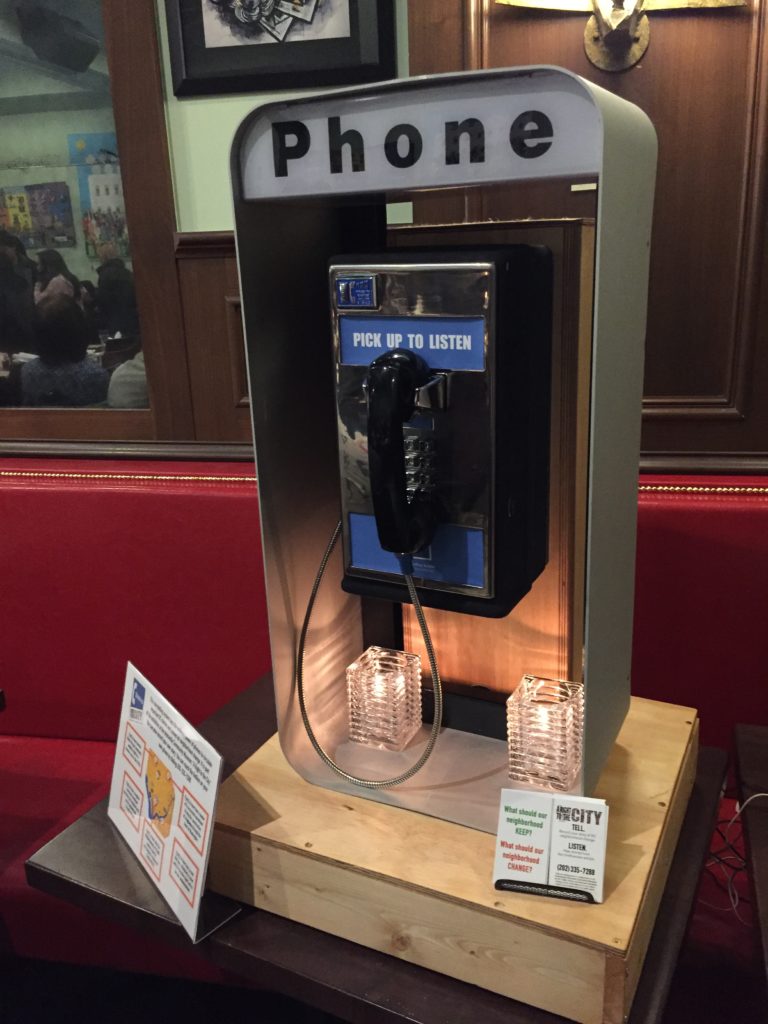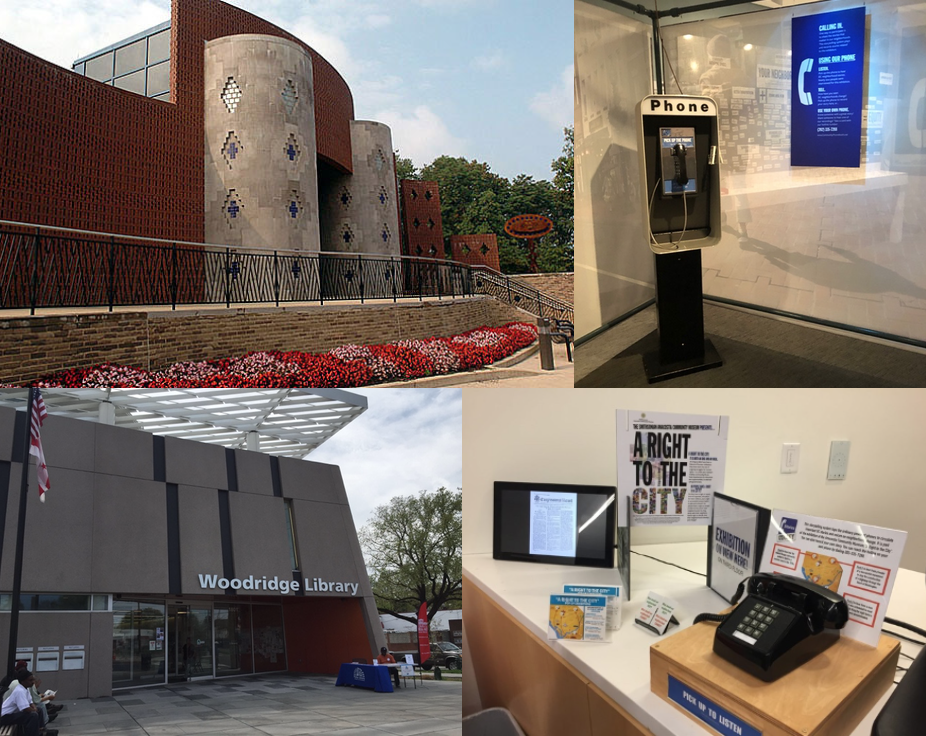Over the past year, I’ve been iterating on the interactivity of the DC Storytelling System. Primarily, I’ve worked on updating the hotline, deploying installations at DC Public Libraries, and sharing our system at a variety of community events with the AU Humanities Truck (such as Adams Morgan Day, DCPS Development Day, and Busboys & Poets’ Saving DC’s History & Culture). I’ve learned a lot from working on these projects, and I want to share some of my personal insights on designing playful community experiences. While this won’t be an exhaustive list of all of our lessons and findings, I hope that my insights are helpful to others who want to create their own playful experiences.
Insight 1: Use physical objects and staging to spark curiosity
When people initially encounter our system at events featuring the Humanities Truck or our desk payphone, their first question is often “what is this?” While at first blush this question might seem negative, it’s precisely the question you want to provoke. Curiosity can be powerful, especially when it drives us to explore and engage with things we don’t understand. So when someone asks “what is this?”, we see it as a solid signal that they are willing to engage.

Photo credit: Benjamin Stokes
One way I’ve found to consistently pique curiosity is by using physical objects in unexpected places. Payphones today are becoming rare, so seeing one at an event immediately makes people wonder why it’s there. Similarly, a large, bright red truck parked in an unusual locations (i.e., the AU Humanities Truck) makes people want to know what’s inside. Both of these are examples of how staging physical objects in unusual contexts can help attract people to your system that normally may have been overlooked.
Insight 2: Continuous systems need a sense of urgency
The DC Storytelling System was intentionally designed to be as accessible as possible. It can be accessed in person from the “A Right to the City” exhibition at the Anacostia Community Museum, and at several installations at DC Public Libraries, or from anywhere in the world using your personal mobile device. But while the system is technically accessible from anywhere at any time, a significant proportion of our recordings have specifically come from community events. This is due in part to the number of people at these events, but I also think it’s at least partially due to the urgency and interpersonal connection that events can bring.

Photo credits: Benjamin Stokes
Technically speaking, our system can be accessible long after an event is complete. For some people, calling later on their own phone might be much more convenient. But when people feel like they can do something at any time, many will put it off and forget about it. But because the event itself is only happening for a limited time, people feel a sense of urgency to use the system immediately. This sense of urgency can be extremely effective at boosting engagement for a continuous system.
Insight 3: You always need to compete for attention
Just because you have a booth or a tent at a community event does not mean people are going to pay attention to you. Often there will be many other exciting things happening at the same time that are also fighting for attention. If you want people to notice you, you’ll need something that helps you stand out. For us this was often the Humanities Truck, but as mentioned before anything that sparks curiosity can be very effective for this.
However, it’s very important to remember that the fight for attention never ends. Even after you’ve managed to convince someone to try your system, you need to hook them and keep them engaged. Otherwise, they’ll just move on to something else that feels more exciting. Through repeated iteration we’ve managed to make our system more engaging in a few ways:
- Polished Mounts: Our mounts have gone through numerous iterations to look more visually appealing and professional. This is especially helpful for initially drawing people in.
- Radio-Style Introduction: We’ve stitched together clips from various stories on the hotline and put it as the first thing you hear when you pick up the phone. This does a much better job of setting the stage and hooking the audience than immediately launching into a dry navigation menu.
- Random User-Submitted Stories: We’re curated a selection of user-submitted stories and hosted them on the hotline for people to listen to. The user-submitted story you get to listen to is random so that there’s a reason to return to the hotline multiple times.
We’re still trying out new ideas for how to make our system more engaging (some of those ideas are outlined in part 2), but these are a few tested ideas you could try out in your own playful systems.
Insight 4: Your system doesn’t exist in a vacuum
Sometimes it’s easy to think that your system is working in a vacuum. But often, your system exists at the intersection of several other community partners and projects that are working towards similar goals. If you don’t reach out to these potential collaborators, you could be missing out on opportunities to enrich and inspire each other.
One of our proudest inspirations to come out our collaboration is the Brookland Oral History Project. Created by the Brookland Civic Association and students of Brookland Middle School, it is a collective, inter-generational conversation between youth and elders in the Brookland community to break barriers and build better collaboration. It is intended to document and share Brookland’s community stories of history and civic engagement. The people behind this project were directly inspired by our project after Woodridge Library’s Eric White and the President of the Brookland Civic Association Dan Schramm visited our satellite exhibit at the library. Dan recorded an excellent story on the phone. We were thrilled to see how the project then evolved with the students at Brookland Middle School with Smithsonian Chief Curator Samir Meghelli to learn more about oral history, including a visit to the library. The AU Humanities Truck was going to be the perfect platform for the students to share their work and engage the public at Porch Fest 2020.
Unfortunately, due to the situation with COVID-19, the project’s community debut had to be delayed. But we are so excited to see how this project has grown and can’t wait for them to show off their work.
This was part 1 of my personal reflection on the DC Storytelling System and the AU Humanities Truck. If you want to read part 2 about our future design plans, you can do so here.
This post was contributed by Mitchell Loewen, a Game Design graduate student at American University, with feedback from the team at The Playful City Lab.
One thought on “Playful Reflections (pt.1): Personal Insights”
Comments are closed.